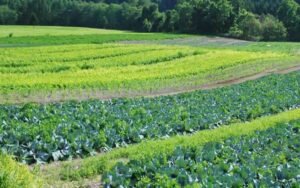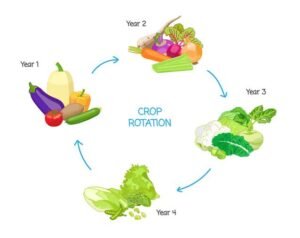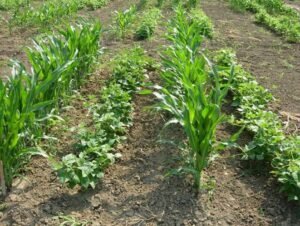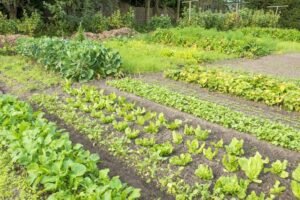Best Crop Planning and Management in Organic Agriculture
Organic Agriculture is regularly promoted and people are getting aware about its significance and thus it is becoming a common farming method among the masses day by day. It is very essential as it promotes a better ecological life balance but is facing a lot of challenges to enter into the policy making arena or the global market where these organic products can be transformed into commodities. Organic Agriculture was very much neglected in the past decades but the promoters have now been getting success in delivering it to the people and is now becoming a promising farming method commercially, socially and environmentally.

People have now become more aware about the health and nutrition that they will get from the foods that they are consuming and so they are not ready to take any such food which contains any type of harmful chemicals or which is obtained using harmful pesticides. Organic farming helps to monitor these issues and the foods produced are also very healthy and with a rich source of nutrients. But it is a very slow process as the foods are grown naturally and it takes a longer time than any other farming methods. So this farming technique is constantly putting more and more efforts to make its space into the global market.
Organic Agriculture practices diverse crop production and every crop requires a different type of nutrient supplements, planning and management, so to optimize the crop growth and its productivity, it is obligatory to understand the planning and management of crops to make it healthy and full of nutrients.
Here in this article we are going to discuss the proper Crop Planning methods and its Management.
Crop Planning and Management in Organic Agriculture
Organic Agriculture focuses on creating a healthy relationship between Man and his mother nature i.e Earth. It helps the farmers to manage the soil health and fertility and it enables them to produce such foods which are free of any harmful chemicals, promoting sustainable development.

Having a diverse type of farming, organic agriculture requires certain conditions to fulfill for making it a success. The farmers are required to plan and manage their crops so as to optimize the growth of crops and its productivity. There are many alternatives to the farmers to help them plan their crops and manage the soil health and fertility of which we are going to discuss the major three – Crop Rotation, Intercropping, and Cover Crops.
- Crop Rotation
Crop Rotation is a process of growing crops by changing its place every year or two, to maintain the soil structure and nutrient level of the crops and to prevent them from soil borne pests. The nutrients for the plant are used continuously in the same place which deteriorates the soil making it unhealthy and drained of these nutrients. Therefore it is essential to do Crop Rotation.
Implementation of Crop Rotation
Crop Rotation is implemented by the following of certain steps which are:

- Selection of Crops – Crops are selected on the basis of different conditions like – which crop would grow well and improve the soil structure and fertility, and would complement with other crops too keeping in mind whether the crop is produced for earning money or for marketing or medicinal purposes.
- Selection of a right variety of Crops – Different varieties have different growing conditions so it is important to select a correct variety of seeds for achieving the desired characteristics.
- Choosing a Crop rotation – It is important to plan the crops that you are going to plant next year or year after that because you can not simply plant any crop. The crops are planted on the basis of many factors.
Recommendations for Crop Rotation

It is recommended to plant winter crops before late planted crops and never repeat the same crop again. Always avoid crop combinations and check the availability and source of seeds and investment required. If the main objective is marketing, make sure that there is a market for your main output and also rotation crops as new crops don’t always succeed in the market.
Legumes should be essentially included in the crop rotation programs as they are used to increase soil fertility. The crops which require high fertility levels should be grown after legume cultivation. Also the high input crops such as sugarcane, potato, maize, etc are recommended to plant before low input crops.
Following these recommendations will help in the prevention of pests and diseases, and it is required to consider some points before the selection of crops which are:
- Moisture availability due to Rain or Irrigation
- Nutrients in the soil
- Inputs such as fertilizers, pesticides, human power and machine power availability
- Crop duration
- Facilities for Marketing & Processing
Advantages of Crop Rotation
Some of its benefits are stated below:
- It improves soil structure by forming tiny holes for air and water to get into the soil.
- It increases the fertility and nutrient content of the soil by fixing nitrogen into the soil.
- It helps in the control of weeds, pests and diseases by breaking the chain of these pests due to Rotation of crops and preventing them from multiplying
- It produces a variety of crops
- It can be used as ploughing of the soil as it helps in aeration, recycling of nutrients, prevention of weeds, pests and diseases.
- It reduces soil erosion
- It reduces pollution
- It increases crop yields
- It minimizes the cost of production
- It helps in increasing the nutrient intake of plants from the soil
Disadvantages of Crop Rotation
Apart from its benefits, crop rotation is sometimes a hindrance to the farmers as well. Some disadvantages are listed below:
- Causes Shade to other crops
- Requires deep digging
- Some crops are grown very high
- No rotation remedies
- Intercropping
Intercropping is a practice of growing two or more crops together in the same piece of land during the same crop season. The main objective of this practice is to increase the productivity of a land by using the resources sufficiently. The selected crops have a variation in their growth duration so that their peak period does not coincide with each other. It is usually practiced to minimize the losses of main crop failure during rainfall or any such incidents.

However, this practice cannot become a success until and unless certain precautionary measures are taken. It requires planning and management of the crops so that the intercropped species remain in balance and each crop should have adequate space between them and should not compete with each other for light, nutrients, etc.
Recommendations for successful Intercropping
The crops for intercropping should be selected with utmost care as every crop has different growing habits, duration, root growth, taxonomy, etc. Therefore, we need to ensure certain requirements and precautions, which are stated below:
- The peak period and the nutrient demands of the crops should not overlap.
- The differences in maturity of the component crops should be at least 30 days.
- Bushy crops should be grown along with tall growing crops.
- The crops that are selected should belong to different families so as to avoid pests and diseases.
- Slow growing crops should be planted in vacant spaces of fast growing crops.
- Shallow rooted crops should be used with deep rooted crops.
- The component crops should show a negligible allelopathic effect.

Implementation of Intercropping
Intertercropping is applied on the farm by making certain planning and arrangements before plantation and proper management after the process. Intercropping is implemented by following certain measures and requirements which are described below.
- Spatial arrangement – It is the arrangement of crops in which they are intercropped. It is of 4 types.
- Row Intercropping – growing of crops in distinct rows.
- Strips Intercropping – growing of crops in strips to allow independent cultivation.
- Relay Intercropping – growing of intercrops just before the main crop reaches its maturity, but before harvesting.
- Mixed Intercropping – growing of two or more crops at the same time but maturing at different times.
- Density of the plants
- The maturation time of the intercrops.
- Architecture of the plants.
Advantages of Intercropping in agriculture:

- Farmers, especially the ones who cannot afford a large capital investment, this method of farming proves to be a blessing in disguise for them as they can maximize their output within their limited field.
- This method of farming helps the farmers to suppress the weeds since the crops take up much more space, leaving aside negligible space for the growth of the weeds.
- Growing two crops alongside each other can be of a great benefit as their interactions would increase the stability of one or both the plants. For example, the plants that are likely to tip over the winds may gain structural support from their companions.

- Crop diversity has proved to be incredibly beneficial in terms of reduction of pests. Trap cropping involves planting a crop that is more attractive to pests than the regular production crops.
Disadvantages of Intercropping in agriculture:
- Harvesting the crops that are grown through intercropping is generally much more difficult than the conventional methods.
- There is a high chance that there would be competition among the crops for sunlight, nutrients and space to grow.
- Large farms with adequate resources may likely receive less benefit out of intercropping.
- Labour costs are more likely to increase when the farming methods involve intercropping.
- Cover Crops
Cover Crops are such plants which are used as a cover for soils to improve its fertility preventing it from any erosion which is not purposed for harvesting. Any plant which covers the soil is termed as a cover crop and it can be any type of leguminous plant or a weed which could produce biomass enormously. It is majorly used due to its fast growing property which covers the soil permanently. It helps in managing soil erosion, soil fertility and quality, water, weeds, pests & diseases, biodiversity and wildlife. It can be grown after harvesting the cash crop as an off season crop.
Types of cover crops
Cover crops are basically categorized in 3 types depending upon their properties. These are:
- Grasses – They grow fastly and leave easily managed residues and it helps in accumulating nitrogen from the soil. Ex – buckwheat, rye, wheat, corn, barley, oats, etc.
- Legumes – It helps in nitrogen fixation. Ex – crimson and white clover, cowpeas, alfalfa, hairy vetch, fava beans.
- Broadleaf non legumes – It absorbs soul nitrogen and works as a green manure. Ex – brassicas, forage radishes, turnips, marigold, mustards, etc.
Selection and Management of Cover Crops
Cover crops are selected on the basis of its type and sequence. Farmers are supposed to not seed the crops when nitrogen levels saturate. Also, the farmers need to consider the time required for proper cover plant decomposition.

The crops are selected on the basis of the below mentioned characteristics:
- The seeds which are cheap, easy to get, easy to harvest, easy to store and propagate
- Rapid growth and could cover the soil in short time
- Resistant against pests & diseases
- Can produce organic matter and dry materials in a large content
- Capable of Nitrogen fixation
- Can be used as fodder crops
- Easy to sow and to manage labourwise
- Capable of regenerating degraded soils
- Have a decompacting root system
- Can satisfy the demands

Cover Crops uses crop monitoring techniques to manage the crops. It helps in elaborating productivity maps so as to redu seeding and fertilization costs. Weather forecasting helps the farmers to schedule the field activities like herbicides. The different tools help the farmers to decide when & how to plant the cover crops and record field operations with the help of activity log, and they can monitor the overall process of plant development, density and health.
Conclusion
Organic farming is a method to produce healthy food crops with a rich source of nutrients and practices diverse crop production, so to properly implement it, the farmers are required to properly plan and manage the crops. Here we studied different planning methods and understood the management of the crops. A good planning maintains a viable crop rotation and intercropping can be a boon for the farm too and when applied with cover crops it can become a productive farming method.




